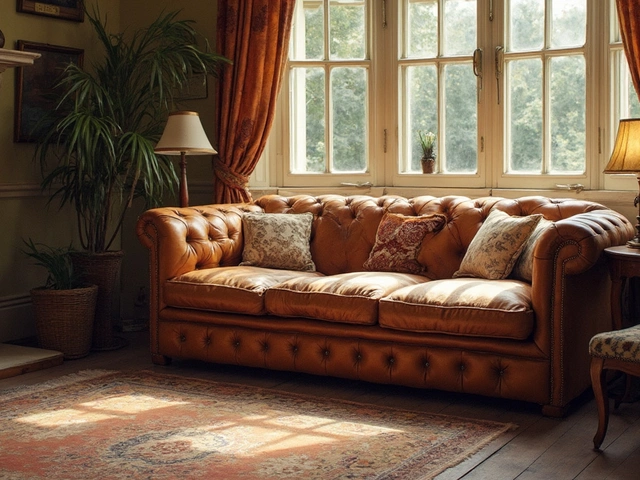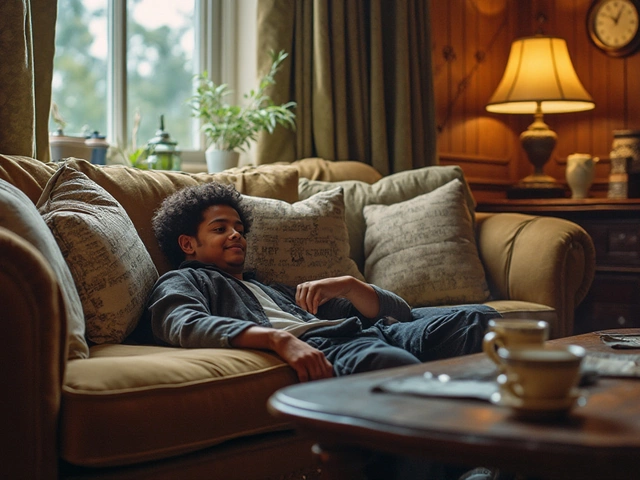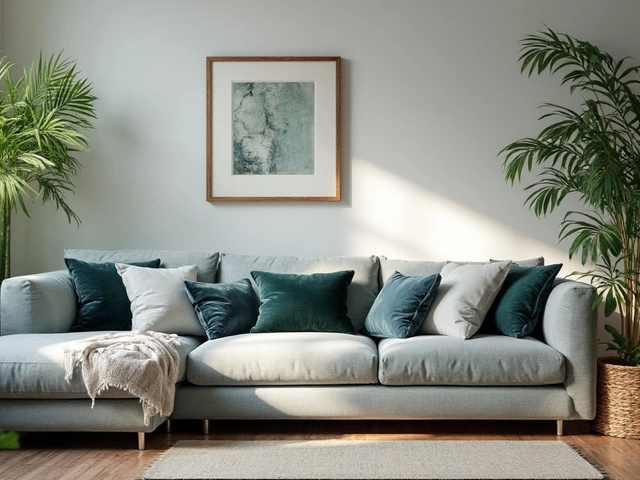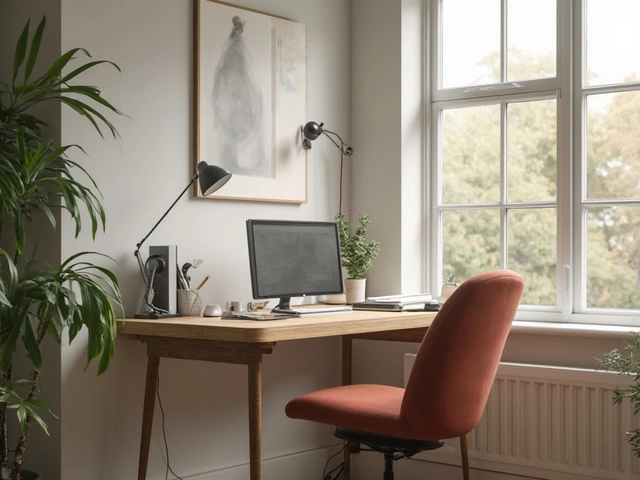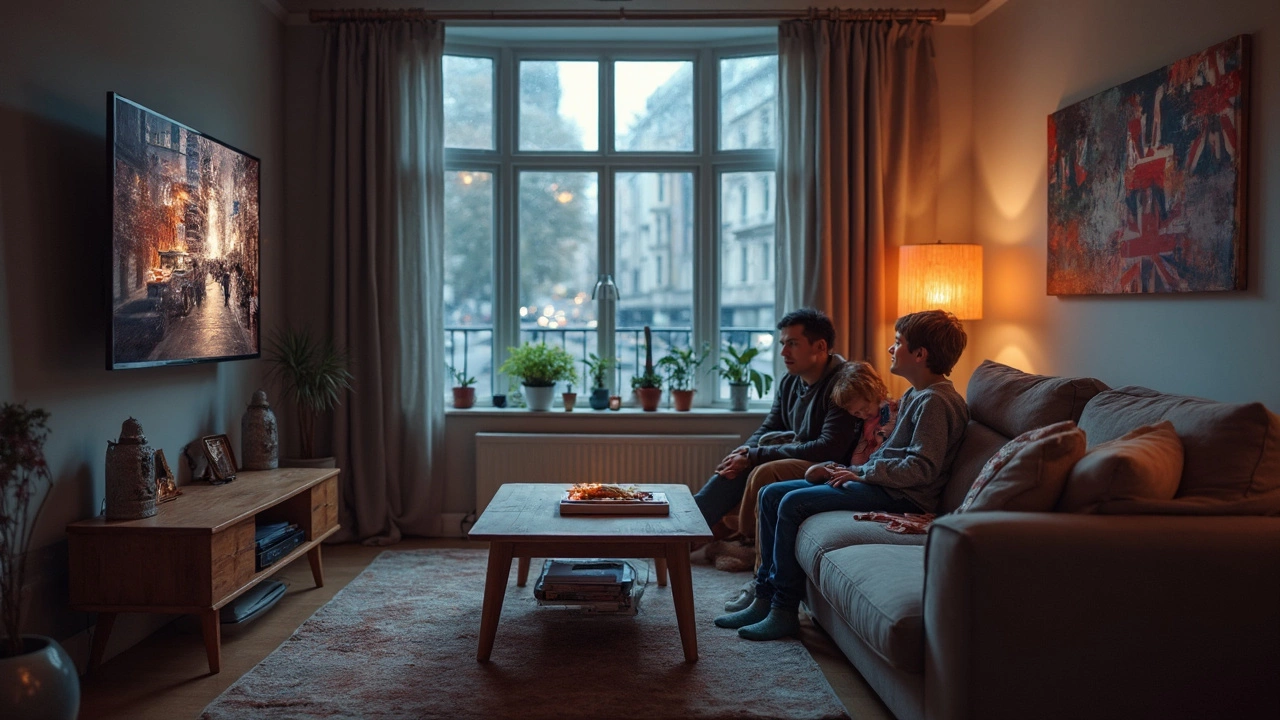 23
May,2025
23
May,2025
If your TV feels way too close, or miles away, you’re not imagining things—it really can make or break your binge-watching sessions. There’s an actual science behind where to put your sofa, and if you get it right, everything just feels better, whether you’re watching the game or dragging friends through another reality TV marathon.
Your eyes don’t want to work harder than they have to. Get the sofa too tight to the screen, and you’ll pick up every pixel (and probably a headache). If you go too far, you lose all the little details you paid for. The sweet spot fixes that, and it’s not just a guess—it depends on your screen size, your room, and even what’s happening between your sofa and the TV. Most folks don’t realize coffee tables can totally mess up the flow, stealing precious legroom and sometimes making everything feel squished.
Ready to get more comfortable and see what you’ve been missing? It’s not fancy interior design—it’s about a few practical tweaks and a measuring tape. And you might not even have to move your coffee table… unless it’s really in the way.
- Why TV Distance Matters
- The Simple Math of Sofa-to-TV Placement
- How Screen Size Changes Everything
- Coffee Tables: The Overlooked Middleman
- Small Spaces and Awkward Rooms
- Making Adjustments for Real Life
Why TV Distance Matters
If you’ve ever flopped down on the couch and felt like your TV was burning your retinas or, worse, that you had to squint to see what’s happening, you’ve bumped into the issue of sofa-to-TV distance. This isn’t just about comfort—it's actually about your eyes and enjoying the picture the way it was meant to be seen.
Your living room setup can make or break how much you enjoy movie night or a game binge. Experts and brands like Sony suggest that getting the distance right helps prevent eye fatigue and can even keep headaches at bay. For HD TVs, sitting too close means you notice pixels and image blur; sitting too far, you lose out on detail and that “big screen” feel. Older TVs weren’t as sharp, but with today’s 4K and 8K models, getting the right distance pulls you into the action without feeling like you’re at the front row of a theater.
Here's a quick look at why the right gap matters:
- Sofa distance helps your eyes move naturally across the screen, so you aren't darting your head back and forth.
- Right placement means better viewing angles, which is a big deal for picture quality—especially on LED, OLED, or QLED screens.
- If there are kids or older adults in the house, the right setup reduces strain for everyone, not just picky TV nerds.
Check out this table with the recommended sofa-to-TV distances, straight from the Consumer Electronics Association (for HD and 4K screens):
| TV Size (Diagonal) | Minimum Distance | Maximum Distance |
|---|---|---|
| 40 inches | 5 feet | 8.5 feet |
| 50 inches | 6.5 feet | 10.5 feet |
| 65 inches | 8 feet | 13.5 feet |
So, if you ignore that magic number and just shove your sofa wherever, you risk ending up uncomfortable, missing details, or even wearing out your eyes quicker. Trust me, a bit of measuring now will save you a lot of annoying fidgeting later.
The Simple Math of Sofa-to-TV Placement
Okay, let’s cut through the confusion: figuring out where to put your sofa isn’t about guesswork. There’s a super simple formula most TV makers and home theater experts actually agree on. You start by looking at your TV size—not the width, but the diagonal measurement in inches. That’s the number you want.
The most common guideline is this: your sofa-to-TV distance should be about 1.5 to 2.5 times the diagonal screen size. So, if you’ve got a 55-inch TV, you’d want your sofa somewhere between 6.9 and 11.5 feet away from the screen. You don’t need to get out the graph paper, either. Quick mental math or a phone calculator does the trick.
| TV Size (inches) | Minimum Distance (feet) | Maximum Distance (feet) |
|---|---|---|
| 43 | 5.4 | 9.0 |
| 50 | 6.3 | 10.4 |
| 55 | 6.9 | 11.5 |
| 65 | 8.1 | 13.5 |
| 75 | 9.4 | 15.6 |
Ever wondered why living rooms with the sofa pushed right up to the wall feel wrong? It’s often because the sofa distance is off. Too close, and your eyes will constantly dart side to side. Too far, and you end up squinting or feel disconnected from whatever you’re watching.
- Start by measuring your TV’s diagonal.
- Multiply that number by 1.5 for a minimum and by 2.5 for a max suggested distance.
- Use that range to find where your sofa feels best, based on your room’s shape and other furniture.
This number isn’t set in stone—some people like to be closer or farther. But if you stick close to the formula, you’ll avoid the biggest comfort mistakes right out of the gate.
How Screen Size Changes Everything
It’s wild how much screen size controls where your sofa should be. A tiny TV up close will look pixelated and uncomfortable, while a huge one in a small room can feel like sitting in the front row at a movie theater—neck pain included.
Most TV makers and retailers agree that bigger TVs need more space, but not as much as people think. The popular rule is that your sofa should be about 1.5 to 2.5 times the diagonal size of your TV away from the screen. So, for a 65-inch TV, you’d want your sofa roughly 8 to 13 feet away.
| TV Size (inches) | Min. Distance (feet) | Max. Distance (feet) |
|---|---|---|
| 43" | 5.5 | 9 |
| 55" | 7 | 11.5 |
| 65" | 8 | 13 |
| 75" | 9.5 | 15.5 |
But it’s not just about size—the clarity (resolution) matters too. 4K TVs let you sit closer without seeing those tiny dots making up the screen. This is good news if you love big TVs but have a medium-sized room.
"For 4K UHD TVs, you can comfortably sit much closer—at about one to one and a half times the TV's diagonal measurement," says the sofa distance guide by rtings.com.
- With 4K, a 55-inch TV can be enjoyed from just 4.5 feet away—and you’ll still get crisp, lifelike images.
- For regular HDTVs, keep a bit more space, or the picture can look softer up close.
The bottom line: check your TV’s size and resolution before moving furniture. Grab a tape measure, look up your TV’s specs, and use the chart as your quick cheat sheet. Don’t let an awkward setup ruin movie night.
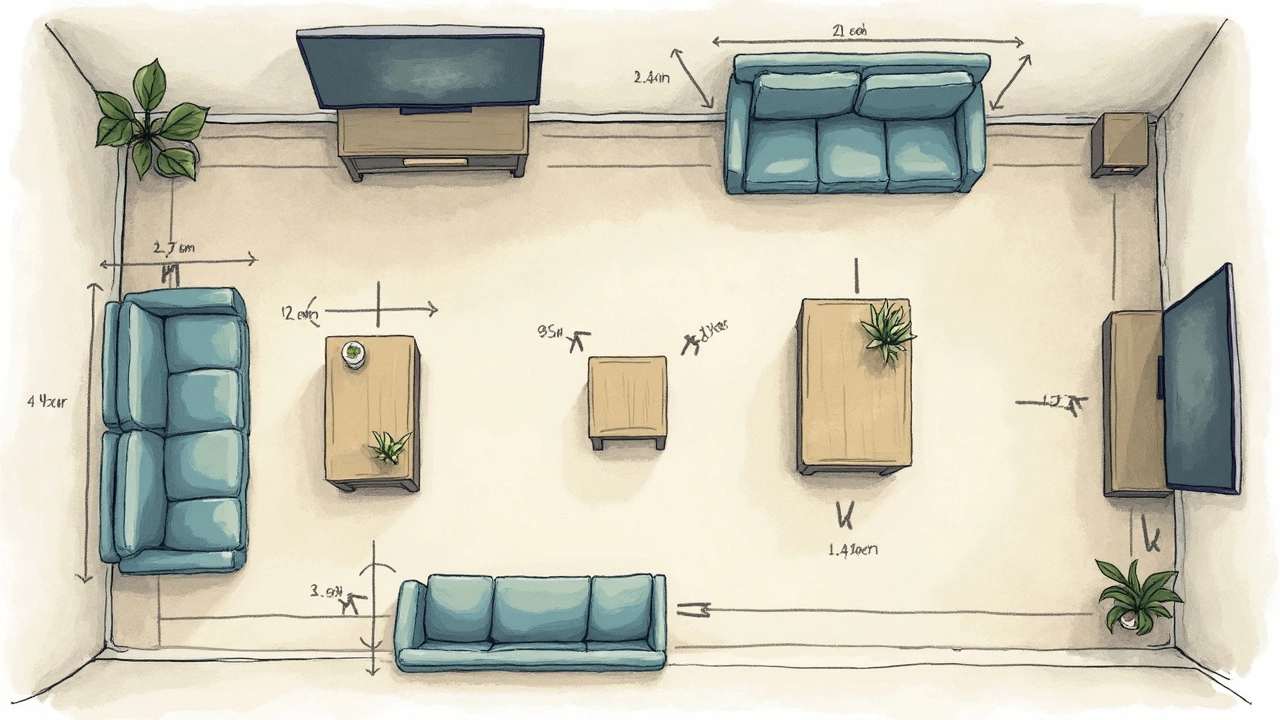
Coffee Tables: The Overlooked Middleman
Here’s the thing: most people think picking the right spot for the sofa distance from the TV is just about measuring the room and calling it a day. But have you ever tried squeezing between the coffee table and the sofa, only to end up with kneecaps dangerously close to your drink? Coffee tables aren’t just a spot for snacks—they change how far back your sofa sits and, honestly, set the vibe for your whole living area.
Coffee tables typically sit about 16 to 18 inches from the sofa, give or take, and are around 18 inches tall. Most living rooms use tables about 40 to 48 inches long and 20 to 30 inches wide. These numbers aren’t random—they let you rest your feet, reach your remote, and still have a clear walkway. Here’s a quick look at average coffee table sizes:
| Dimension | Average Range |
|---|---|
| Distance from Sofa | 16-18 inches |
| Table Height | 16-18 inches |
| Table Length | 40-48 inches |
| Table Width | 20-30 inches |
So what does this mean for you? If your table is oversized, you’ll have to scoot your sofa back, which throws off the perfect TV viewing zone. Too small, and you end up with clutter or a tight squeeze. The real trick is to measure everything as a group—TV, sofa, and table. Eyeballing it almost never works. Try these tips for a setup that actually works:
- Keep at least 18-24 inches of walkway space between the coffee table and the TV stand. This way, there’s enough room to walk and your coffee table isn’t blocking your view.
- Double-check that the coffee table doesn’t force the sofa further than what’s comfy for watching TV. Standard TV viewing distance is roughly 1.5 to 2.5 times the diagonal size of your screen. Throw a big table in the middle and you’ll be scooting too far back.
- If your living room is tight, consider a smaller table or try a couple of nesting tables. They can be pushed aside when you need the space.
Coffee tables might seem boring, but change one thing—even just the shape or size—and you’ll notice the whole living room feels different. Take a minute to measure; it makes all the difference for comfort, looks, and, yes, where you plant yourself for that movie night.
Small Spaces and Awkward Rooms
Not everyone has a huge living room where everything falls into place. Sometimes, your space is small, shaped weird, or packed with stuff. But you still want your couch and TV to work together without anyone straining their neck or squinting for details.
The first thing to remember: you don’t need to cram your furniture up against the wall just because the room is tight. In fact, the TV viewing distance should always be based on your actual screen size—no matter what. For a 50-inch TV, the sweet spot lands around 6 to 8 feet away. Even if you’re working with less space, try to stay as close to this rule as possible.
Awkward corners, doors in the way, or odd windows can complicate things. But there’s always a hack:
- If the sofa and TV can’t be centered, angle them towards each other. Even a slight tilt makes a big difference.
- Mount your TV on a wall bracket that moves or swivels. This gives you more flexibility with where you put your sofa.
- If there’s a coffee table, make sure it isn’t eating up precious walkways or making you push the sofa too far back. You want your sofa distance to be just right—don’t let the table boss you around.
- Consider slimline furniture. A thinner coffee table or a sleek media unit opens up more space for comfortable viewing, so you’re not squeezed right up to the screen.
- Use rugs or shelving to help “zone” the TV area, so even in a small room, you can create a visual separation that helps everything feel more intentional and less cramped.
Don’t forget, you can always slide your sofa forward a few inches when you’re settling in for a movie night, then push it back if you need more room. Your setup doesn’t have to be permanent. Small changes really add up in tight spots.
Making Adjustments for Real Life
Not everyone lives in a show home. Most of us have to work around walls, windows, and furniture that just won’t budge. So, what happens when the recommended sofa distance from the TV doesn’t fit your living room setup? Don’t stress—you can still get close to that perfect spot with a few tweaks.
If your space is tight or oddly shaped, you can:
- Angle your sofa instead of forcing it straight-on. This way, everyone gets a clear view.
- Go for a wall-mount TV; it shaves a few inches off the depth, freeing up floor space for coffee tables or foot traffic.
- Try a compact or low-profile coffee table—makes the area feel less cramped and keeps the walking path clear.
- Pick a swivel mount if you want to change the angle depending on where you're sitting.
Even the height of your TV and sofa matters. Most people find the TV should be roughly at eye level when they're sitting down (usually about 42 inches from the floor to the center of the TV).
Eye strain is a real thing. The American Optometric Association suggests you should not have to look up or down more than 15 degrees to see your screen. And if you’ve got gamers or kids in the house, the right distance means fewer complaints about neck aches.
| Screen Size | Min Distance (ft) | Max Distance (ft) |
|---|---|---|
| 43" | 5.5 | 9 |
| 55" | 7 | 11 |
| 65" | 8 | 13.5 |
| 75" | 9 | 15.5 |
Here’s the thing: your coffee table shouldn’t block the walkway or force you to tiptoe around to get comfy. If it’s always in the way, consider one with storage, wheels, or even nesting tables you can move around as needed. The space between your coffee table and sofa should be about 16-18 inches, enough room to walk and put down a drink but not too far to reach.
Got roommates or a big family? Don’t forget about moving the seating around for movie nights or game days. Light, modular sofas or added floor cushions make a flexible setup way easier.
If you’re dealing with glare from windows, close the blinds or get sheer curtains so you can tweak the light without turning your living room into a cave.
